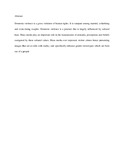| dc.description.abstract | Domestic violence is a gross violation of human rights. It is rampant among married, cohabiting and even dating couples. Domestic violence is a practice that is largely influenced by cultural hues. Mass media play an important role in the transmission of attitudes, perceptions and beliefs castigated by these cultural values. Mass media over represent violent crimes hence presenting images that are at odds with reality; and specifically enhance gender stereotypes which are born out of a people’s attitudes, perceptions and beliefs. These gender stereotypes arising from media reports on domestic violence are likely to lead to more similar form of violence. This paper assesses the extent to which media coverage of cases of domestic violence has perpetuated gender stereotypes among Kenyan media consumers thus fuelling more violence. Specifically, the paper looks at the depiction of domestic violence victims basing on the reporters own choice of words as well as the reports or comments of eye witnesses or views and comments by those who consumed the story. The paper also addressed the possible causes of propagation of gender stereotyping in reporting cases of domestic violence. The issues of possible personal biases, journalistic unprofessionalism and cultural interference were investigated. Content analysis provided a basis for synthesis of media reporting of domestic violence cases. Domestic violence has for a long time been viewed as aggression towards a female partner by a male partner. However, cases of men being battered by their female partners have been reported. Hence this paper looked at the depiction of both male and female genders as either victims or perpetrators of domestic violence. The concept of mass media effects on their consumers was analyzed using the principles of Cultivation theory. The paper confirms that coverage of domestic violence in Kenya is full of gender stereotype depiction and is likely to fuel domestic violence. | en_US |

